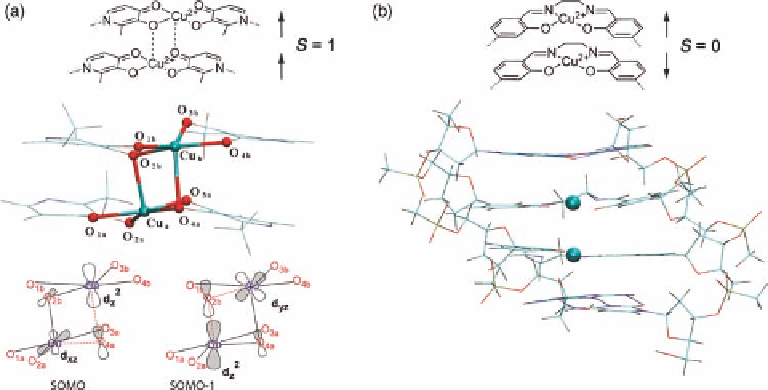Chemistry Reference
In-Depth Information
Figure 9.20 Different magnetic behaviours of stacked metal base pairs containing para-
magnetic Cu(II). (a) The stacking of hydroxypyridone-Cu(II) base pairs leads to a ferromagnetic
interaction between the Cu(II) centers due to the formation of square [Cu
2
O
2
] arrangements
resulting in an orthogonal arrangement of the single occupied molecular orbitals. (b) In
contrast, the stacking of salen-Cu(II) base pairs leads to an antiferromagnetic interaction
between the Cu(II) centers. Reprinted with permission from Ref. [58]. Copyright 2009 WILEY-
VCH Verlag GmbH & Co. KGaA, Weinheim.
Motivated by the vision of future DNA-based molecular electronics [20,59], first
experiments on the electrical conductivity of metal base pairing DNA were undertaken
recently. To this end, short DNA double strands containing no, one or three metal base
pairs were covalently attached between the two ends of single-walled carbon nanotubes,
as depicted in Figure 9.21a [60]. Microcontacting of the nanotubes on either side allowed
the measurement of the electrical current through the devices in response to the applied
voltage. It was found that the measured conductivity significantly responded to the pres-
ence or absence of metal ion(s) coordinated by the metal base pair(s), which was demon-
strated by the cyclic switching of the conductivity after treating the system in turns with
EDTA and the metal ion, respectively (Figure 9.21b). This effect was only observed when
using the double strands containing the hydroxypyridone ligands, and no effect of metal
addition was seen for the conductivity of the unmodified control strand. Furthermore, the
duplex containing three consecutive metal base pairs indicated a somewhat higher con-
ductivity than the one with only one metal base pair.
By employing a different approach, other researchers recently investigated the mobility
of charge carriers in metal base pair containing DNA strands using microwave spectros-
copy, thus coming to similar results [61].
9.6.4 Future Directions
The topic of metal base pairing is still a pretty young one, with important milestones already
left behind, such as the proof of synthetic feasibility, the specific binding of various

Search WWH ::

Custom Search